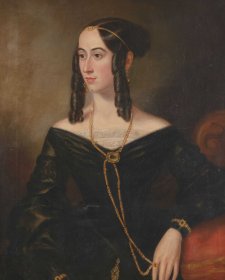The Gallery will be open until 9pm this Friday, Saturday and Sunday.
Frances Samuel (1818–c. 1900) arrived in Sydney in 1832 with her widowed mother Lydia; younger brother Saul; and an uncle, Abraham Lyons. They had come to the colony on the recommendation of Frances’s other uncles, Samuel and Saul Lyons, both of whom had become prominent businessmen in the 1820s. Saul Lyons had come to Sydney a free settler; Samuel Lyons had arrived as a convict after receiving a life sentence for theft in 1814. By 1827, despite escapes from custody and other misdemeanours, Samuel had been given a ticket of leave and established himself as a merchant, money lender and auctioneer. Newspaper references to Frances indicate that she enjoyed a genteel existence here for several years before returning to England with her mother in March 1841. Frances married in London in September 1850 and gave birth to a son in 1851. Frances lost both her husband and son during the following decade: the 1861 England census recording her as remarried and residing in St Pancras with Lydia in a household warranting several servants. Letters to her nephew, Edward, written in the 1890s, show that Frances was living in Earl’s Court in her later years.
Maurice Felton (1803–1842), artist and doctor, travelled to Australia as the surgeon on an immigrant ship called the Royal Admiral which arrived in Sydney in September 1839. Although listed in July of the following year as one of the colony’s ‘duly qualified medical practitioners’, Felton appears to have been having more success as a painter. A few months after his arrival, The Australian was applauding Felton’s portraiture, declaring ‘for faithfulness of likeness and brilliancy of execution, they rival the productions of many of our best artists at home’. His work attracted the attention of arts patron and colonial businessman Alexander Brodie Spark, who in May 1840 commissioned Felton to paint a portrait of his wife. Spark also became one of the prominent citizens depicted by Felton over the next two years. In late 1841, Felton showed at his home in Hunter Street a number of portraits and ‘some beautiful views of the interior of the country’. This exhibition was a lottery whereby subscribers, for one pound, purchased the chance of owning an example of ‘Mr Felton’s talents in the delightful art of painting’. The exhibition appears also to have been a means by which Felton attempted to provide for the family he had relocated to Australia two years earlier. He died, aged thirty-nine, in March 1842.
Purchased 2011



On one level The Companion talks about the most famous and frontline Australians, but on another it tells us about ourselves.



Emma Kindred examines fashion as a representation of self and social ritual in 19th-century portraiture.



Visit us, learn with us, support us or work with us! Here’s a range of information about planning your visit, our history and more!